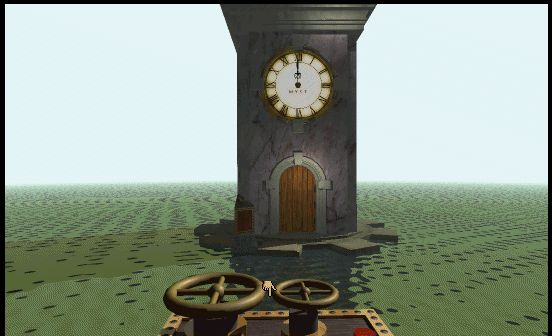While seeking out marker switches, the player may have
entered the library; if not, the player will do so from later exploration,
finding mostly dead ends everywhere else (interactive objects like the planetarium viewfinder appear to be pointless at this point).
 |
| "Everything is broken on this piece of $#*% island!" |
If the player has not flipped any marker switches, they will
find the map on the wall to be interesting, but useless for such a small
island. If the player has flipped all the
marker switches it is possible to reach (the one by the clock tower is
currently unreachable), then they would surely touch the blinking icon and
intuitively understand that the tower is turning based on the grinding sound;
the player would also notice the hitch and that the line turns red when it
lands on some icons.
The player may not necessarily make the conclusion that the
marker switches are connected to the interactive map, if no switches have been
flipped, or if all have been. However,
if the player, on exploration, flipped a few switches, but not all, they are
more likely to realize what the marker switches are for, and will flip the rest
of them.
The fireplace will appear to be a strange dead end, similar
to the generator room or planetarium.
However, the player will come to understand the blue and red
books quickly, finding static without the nearby page placed within, and less
static with it, revealing Sirrus and Achenar.
It seems clear that the men trapped inside need pages of their
respective color to lessen the static and talk without interruption, at the
very least. Sirrus is calm, while
Achenar is desperate, but they both urge for pages.
 |
| "We gotcher red pages, yer blue pages, whatcha need?" |
The player may come to the conclusion that the brothers are
trapped in those books, and need pages to get out, but it is somewhat more
likely that the player will think that the books are more like videophones, at
least for now, since those books do not offer flybys (as static-filled as they
might be) like the book of MYST did.
In any case, Sirrus and Achenar need the player's help, yet
Atrus just warned that one of them (probably Achenar, he claims) burned most of
his books. It certainly seems that
Achenar is the crazier of the two. The
player may consider helping Sirrus, but he seems a little too relaxed, and keeps the door open for suspicion.
Besides the prison books, the main shelves of the library
hold the books Atrus mentioned, most burned badly. A few did survive, and they become easily
identifiable by their pristine spines.
The player may read these and find them fascinating, as well
as note the clues for later puzzle-solving, or the player may find them boring
and think "I don't want to read when I play a game."
Now, this secondary type of player will be completely weeded
out by this point, if they have not given up previously. These four unburned books are keys to
accessing nearly the entire game.
Oftentimes, in RPGs, there are big blocks of text in the
gameworld, tomes the player can read for no more than background information
about the world. They are mostly flavor
text, while pertinent or necessary information is mostly found in cutscenes,
small pieces of text, or other non-readable format. In MYST, the solutions to puzzles are found
in diagrams in these books, not in the text itself, but even so, an impatient
player would be deterred.
 |
| I think Atrus doesn't know how to write sheet music. |
However, the text of these books does what it can to be
entertaining apart from the content, giving mystery and intrigue that encourage
the player to read them. The journal for
Channelwood, for instance, has ink in multiple colors. The text for the Selenitic journal disappears.
The final pieces of interest in the library are the
paintings, which, when touched, open and close a secret passageway behind the
bookshelves. The passage leads to the
tower, which Atrus previously mentioned rotates.
Upon entering the tower, the player will explore and
discover a clue opposite the window, and it is here that the player will
discover the first 'real' puzzle of the game.
Read Part VI: Getting to the Mechanical Age
Read Part VI: Getting to the Mechanical Age
No comments:
Post a Comment